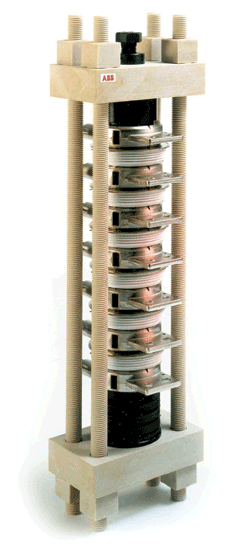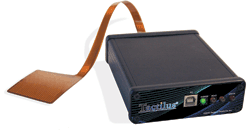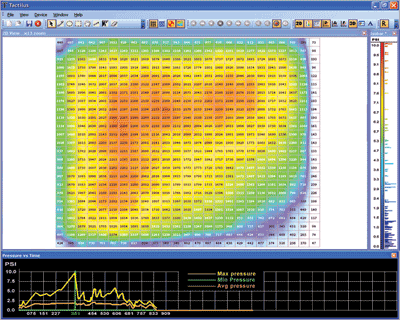Sensing pressure to boost heat-sink performance
For heat sinks to work most efficiently, users must see that they are designed and installed so as to maximize heat flow
BY CARLOS PAIS
Sensor Products Inc., Madison, NJ
www.sensorprod.com
and NED ISAACS
Technical Writing Consultant
Modern microprocessor-controlled electronics and high-power LED-based lighting operate at elevated temperatures due to Joule heating. As a result, the use of heat sinks to dissipate temperature has become very important in electronic system designs. But for heat sinks to work most efficiently, users must be certain that they are installed in such a way as to maximize heat flow. This can only been done if engineers make the correct measurements using appropriate sensors when installing heat sinks.
Basic heat sink operation
Heat conducted from the electronic component to the heat sink is governed by Fourier’s law of heat conduction:
q = −k × A × dT/dx
where q is the heat conducted, k is the thermal conductivity of the heat sink, A is the cross-sectional area through which heat is conducted, and dT/dx is the temperature gradient between the heat sink and the component being cooled. So it follows that the amount of heat conducted into the heat sink is directly proportional to the cross-sectional area, “A,” through which that heat is conducted.
When there is uneven contact between the heat sink and the electronic component, the value of “A” is reduced, as is the resulting amount of heat conducted. Such uneven contact manifests itself in variations in the pressure distribution between the two adjacent surfaces. Therefore, it is important to measure the pressure profile on mating surfaces to assure optimum contact.
Unfortunately, many manufacturers do not attempt to quantify the pressure profile. They rely instead upon tightening mounting screws using uniform force, which they assume will lead to even pressure distribution. But tightening the screws without some method to reveal pressure distribution at the surface can cause warpage or distortion of the heat sink or of the electronic component. This, in turn, can lead to loss of contact or uneven pressure distribution between the mating surfaces.
Pressure-sensing approaches
Traditionally load cells have been used to measure pressure. However, they only measure the overall force exerted upon the two surfaces, not the pressure distribution across the entire surface. They provide no information on the pressure gradients between the surfaces. The omission of this vital pressure distribution data can have serious consequences.
The need to measure pressure distribution at the surface has led to the development of two specialized methods. The first involves the use of pressure-indicating sensor film. The second method involves the employment of electronic tactile surface-pressure mapping systems, which reveal how pressure is exerted between two surfaces in real time.
Researchers have used tactile pressure-indicating sensor film for the past 20 years to study heat conduction and have reported the results in heat sink literature. Pressurex sensor film is a thin Mylar-based film that contains a layer of tiny microcapsules that burst upon the application of force to produce an instantaneous and permanent high-resolution image of pressure variation across the contact area. This film can be placed between two surfaces that touch, mate, or impact. When the film is removed, the pressure distribution profile which shows where variations in pressure occur between contacting surfaces is immediately visible on the film.
Conceptually similar to Litmus paper, the change in color intensity of the film is directly proportional to the amount of pressure applied to it the greater the pressure, the deeper the color. The color variations in the film can reveal surface pressures from 2 to 43,200 psi (0.14 to 3,000 kg/cm2 ).
Practical examples
ABB Switzerland Ltd recommends the use of pressure-indicating film during the setup and mounting of their water-cooled Press-pack High Power Semiconductors heat sinks (fig. 1). The film is used to prevent uneven pressure that will lead to deformation of the housing and internal stress between the different device layers, causing it to fail prematurely during load cycling.



Fig. 1. Pressure-indicating film is used to properly mount the heat sinks in for ABB’s Press-pack High Power Semiconductor (top). Uniform pressure distribution between the heat sink and the semiconductor is seen in the middle film, where the white area is a hole in center of the film for a heat-sink mounting screw. In contrast, when there is poor pressure distribution (bottom), the film shows deep red areas of high pressure and white areas where there is very little contact between the heat sink and the semiconductor.
Many manufacturers routinely use pressure-indicating sensor film (manufactured by Sensor Products under the Pressurex brand) to diagnose pressure distribution in their designs. For example, Robin McCarty of Marlow Industries uses the film to investigate thermal interfaces between thermoelectric power generators and heat sinks and identify the high spots.
Marc-Jason Renaud of Curtis-Wright Corp. uses sensor film to evaluate the compressive force applied on circuit-card-assembly components when their thermal frames are installed. The forces on the components must be minimized to prevent long-term operational damage.
Tactile pressure-indicating sensor film is also used in other electronics-related processes, including wafer bonding and polishing, printed circuit board and other lamination press applications, and LCD panel displays.
Surface-pressure mapping
Electronic surface-pressure mapping allows the engineer to measure actual, real-time contact force and pressure distribution data. This technique provides time-dependent pressure information, unlike pressure-indicating film, which provides a static “snapshot” of a maximum pressure profile.
Using systems such as the Tactilus developed by Sensor Products Inc., design engineers can confirm FEA predictions as well as monitor the changing surface pressure between components during assembly. Since the sensors are thin and flexible, they can be placed between two contacting surfaces with minimal affect on the overall assembly. This matrix-based technology utilizes resistive sensors where the resistance of the sensing point is proportional to pressure.
Electronic surface-pressure mapping is especially useful in developing procedures for mounting heat sinks. Both chipset and heat sink surfaces are rigid, and can have as few as three points of contact between them. This could lead to very high localized pressure during the assembly process. Tactile pressure mapping allows the engineer to monitor the pressure distribution while the assembly is torqued to minimize the stress on the chip and to assure that the final mounting parameters result in even pressure distribution between all components.
The Tactilus surface-pressure mapping system specifically measures the interface between processors and their heat sinks (see Fig. 2 ). The sensing element is 50 × 50 × 0.38-mm thick, has 625 total sensing points in a 25 × 25 array, and a pressure-sensing range of 0 to 100 psi (0 to 7 kg/cm2 ). The element can be scanned at a rate of 100 times/s and data from the sensor points are collected and processed using a proprietary Windows-based tool kit. The technology also uses advanced electronic shielding techniques to maximize the sensor’s immunity to noise, temperature, and humidity.



Fig. 2. With the Tactilus Sensor system (top), a 25 x 25 array of sensors can be placed between a CPU and a copper heat sink (middle, note that the sensor is specifically sized to the chip). The data collected in this way is used to generated pressure maps (bottom; green represents low pressure, orange higher pressure), graphs, and statistics.
A leading large-computer manufacturer in the U.S. is using this technology, and it has also been used to aid in the selection of thermal material used in conjunction with heat sinks.
In one instance, the thermal material required 125 psi for it to align in a direction where it would conduct heat. When the parts were assembled, Tactilus found that the heat sink warped from the force of the mounting bolts. As the heat sink distorted, it lost contact with the bottom plate, resulting in low contact pressure over 80% of the interface.
Sensor film in manufacturing
Heat sinks are used in many manufacturing operations to transfer heat to and from parts being assembled. Josea Macias of Foxconn uses pressure-indicating sensor film for calibrating a heat/pressure bar in bonding machines that adhere Chip on Flex devices to liquid crystal display panels. The bar pressures and heats the assembly to achieve bonding. Macias said that the pressure-indicating film is very helpful in determining which tilt adjustments to make to achieve the proper contact pattern between the bar and the assembly.
Pressure-indicating film is also useful in ensuring heat flow during welding and joining operations. This is particularly important for the power industry. As a general practice, new tooling should be checked for proper operation before being used in any manufacturing operation and, once in place, production tooling should also be routinely checked as part of a periodic maintenance regimen. ■
Advertisement
Learn more about Sensor Products





